Polar bears and walruses, both Arctic inhabitants, are remarkably different in several ways.
Polar bears have elongated bodies. They are solitary hunters and primarily eat seals. In contrast, walruses have bulky bodies and long tusks. They are sociable creatures that feed mainly on benthic invertebrates. Additionally, polar bears are known for their strong swimming abilities. Conversely, walruses prefer to remain near shorelines, hauling out on sea ice or land.

The Arctic, a kingdom of ice and snow, is home to extraordinary creatures like the polar bear and the walrus. Though they share the same cold environment, these two species are as different as night and day, each with their own unique adaptations and ways of life.
Did you know that a polar bear mother cares for her cubs for 2.5 years, while a walrus calf may stick with its mother for up to 5 years?
Intrigued to learn more about these Arctic dwellers and their mesmerizing differences? Let’s dive deeper into their icy world and discover the remarkable secrets they hold. There’s a world of wonder waiting for us, so let’s explore it together.
Polar Bear vs. Walrus – A Quick Comparison
| Feature | Polar Bear | Walrus |
| Scientific name | Ursus maritimus | Odobenus rosmarus |
| Family | Ursidae | Odobenidae |
| Body Shape | A stocky, elongated body | Large, bulky body with prominent tusks |
| Size | Adult males: 8 – 10 ft long, weight: 350-700 kg | Adult males: 7.25 – 11.5 ft long, weight: 800-1700 kg |
| Diet | Carnivorous, mainly seals | Omnivorous, mainly benthic invertebrates |
| Habitat | Arctic regions, dependent on sea ice | Arctic regions, coastal areas and sea ice |
| Social Behavior | Mostly solitary, mothers care for cubs | Social animals, gather in large herds |
| Lifespan | 25-30 years | 30-40 years |
| Gestation Period | 195-265 days | 15-16 months |
| Defense Mechanisms | Powerful build, sharp claws, strong jaws | Large size, long, sharp tusks, form defensive circles |
| Interaction With Humans | Hunted traditionally, attraction for wildlife tourism | Traditionally hunted, attraction for Arctic tourism |
| Threats | Climate change, pollution, overhunting | Climate change, hunting, increased human activity in the Arctic |
| IUCN Status | Vulnerable | Vulnerable |
Polar Bear vs Walrus – What Are the Key Differences?
Polar bears and walruses, two iconic giants of the Arctic, share a life in the northernmost latitudes. Both have adapted to their icy environment with impressive physical traits and behaviors.
But despite these commonalities, these two Arctic dwellers are distinctly different in numerous ways. So, let’s delve into their icy world and unearth these fascinating differences.
1. Taxonomy and Scientific Classification
Both the polar bear and the walrus belong to the same domain, kingdom, phylum, class, and order. The differences arise at the family, genus, and species levels.
Polar bear
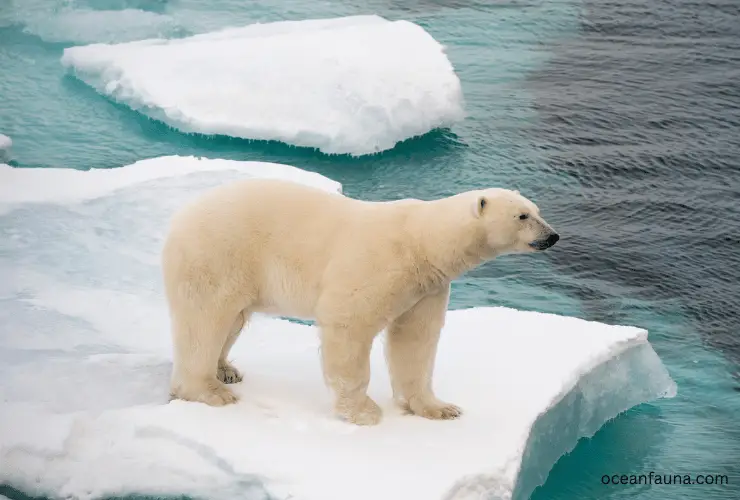
Polar bears are part of the Ursidae family, which includes other bears like grizzly bears and black bears. Their genus is Ursus, and their specific species is Ursus maritimus.
Walrus
On the other hand, walruses are part of the Odobenidae family, a family of pinnipeds exclusive to them. The walrus’s genus is Odobenus, and its specific species is Odobenus rosmarus. The two main subspecies of walruses are:
- The Atlantic Walrus (Odobenus rosmarus rosmarus)
- The Pacific Walrus (Odobenus rosmarus divergens)
| Taxonomic Rank | Polar Bear | Walrus |
| Domain | Eukarya | Eukarya |
| Kingdom | Animalia | Animalia |
| Phylum | Chordata | Chordata |
| Class | Mammalia | Mammalia |
| Order | Carnivora | Carnivora |
| Family | Ursidae | Odobenidae |
| Genus | Ursus | Odobenus |
| Species | U. maritimus | O. rosmarus |
2. Habitat and Distribution
Both polar bears and walruses are iconic creatures of the Arctic. Still, they have distinct differences in their habitats and distribution due to their unique survival needs. Let’s explore this further.
Polar bear
The polar bear, also known as the sea bear, is native to the Arctic regions of
- Canada
- Alaska (USA)
- Greenland
- Russia
- Norway.
They live in a variety of habitats within the Arctic region, including coastal areas, islands, and seas that are ice-covered for much of the year.
A polar bear’s range can be vast, with some individual bears having a home range of several thousand square kilometers. Their distribution is primarily influenced by the availability of sea ice and their prey.
Walrus

The walrus inhabit the icy waters of the Arctic Ocean and its adjoining seas. Both the subspecies of walruses have varied distributions.
- The Atlantic Walrus: The Eastern Canadian Arctic, Greenland, and parts of Russia.
- The Pacific Walrus: Northern seas of Russia and Alaska.
Walruses are typically found on the sea ice and use their tusks to haul their enormous bodies out of the icy water. They spend significant time on sea ice and coastal beaches, as described by the University of Alaska Fairbanks.
During summers, when ice melts, walruses can be seen on the shores of islands and continents around the Arctic.
| Aspect | Polar Bear | Walrus |
| Habitat | Arctic regions, sea ice, coastal areas | The Arctic Ocean, sea ice, and coastal beaches |
| Distribution | Canada, Alaska (USA), Greenland, Russia, and Norway | Atlantic Walrus: Eastern Canadian Arctic, Greenland, parts of Russia. Pacific Walrus: Northern seas of Russia and Alaska. |
3. Physical Appearance
Polar bears and walruses possess distinct physical traits that set them apart.
Polar bear

Polar bears are the biggest species of bear and one of the largest land predators. Adult males typically weigh between 350 and 700 kg and can reach 8 to 10 feet long. Females are generally around half the size of males, as detailed by the Alaska Department of Fish and Game.
One of the most notable features of a polar bear is its white fur, which actually consists of clear, hollow tubes filled with air. This adaptation provides excellent insulation and camouflage against the Arctic ice.
Beneath the fur, a polar bear’s skin is black, which aids in absorbing and retaining heat from the sun. They have a long neck and a narrow, elongated head, which is useful when they put their heads in holes to catch seals. They also have large, paddle-like paws (nearly 12 inches wide) for swimming.
Walrus
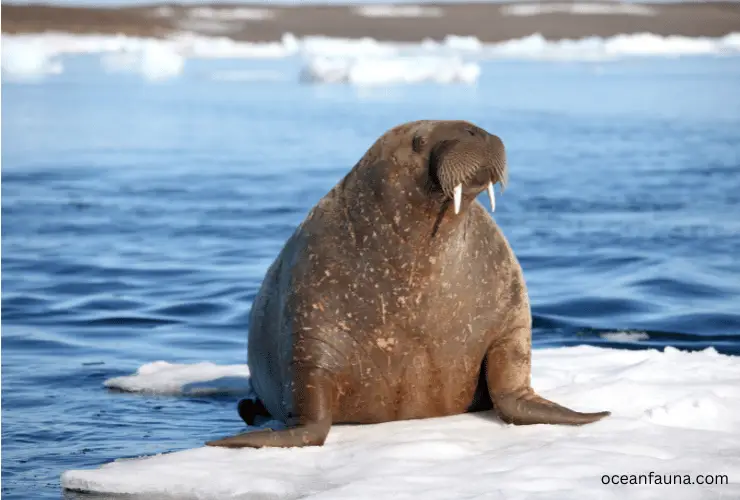
Walruses are one of the largest pinnipeds. Adult male walruses can weigh anywhere between 800 to 1,700 kilograms, with some reaching up to 2,000 kilograms. They measure 7.25 to 11.5 feet in length, as described by the Alaska Department of Fish and Game.
Their most prominent features are their long, curved tusks, which are actually long canine teeth that can grow about one meter long. Both males and females have tusks.
They also have a thick layer of blubber (fat) beneath their skin, which keeps them warm in freezing temperatures. Their skin, covered in short reddish or brownish hair, appears wrinkled and is especially thick on the neck and shoulders of males.
The body of a walrus is rounded and bulky, and they have a small head, short muzzle, and small eyes. They have a mustache of stiff bristles (vibrissae) that aids them in searching for food on the seafloor.
| Physical Feature | Polar Bear | Walrus |
| Size | Adult males: 550 to 1,700 pounds, 8 – 10 ft | Adult males: 800 – 1,700 kg, 7.25 – 11.5 ft |
| Color | White fur, black skin | Reddish or brownish skin |
| Notable Features | White fur, elongated head, large paddle-like paws | Long tusks, thick blubber, wrinkled skin, stiff whiskers |
4. Diet and Feeding Habits
Polar bears and walruses have very different diets and feeding habits dictated by their physical attributes and the ecosystems they inhabit.
Polar bear
Polar bears are primarily carnivorous and are classified as marine mammals. A significant part of their diet consists of seals, particularly the ringed seal and, to a smaller degree, the bearded seal.
Their feeding habits are closely tied to the sea ice from where they hunt their prey. When a polar bear spots a seal’s breathing hole, it will patiently wait or stalk its prey. Then, with a powerful swipe of its clawed paw, it will attempt to pull the seal out of the water.
In times when seals are not readily available, polar bears will eat whatever they can get, including
- Fish
- Birds
- Eggs
- Rodents
- Shellfish
- Crabs
- Larger mammals like the walrus and beluga whale.
They also resort to scavenging from carcasses, like those of dead whales. This type of diet is high in fat content, which is essential for the bear to build up its own fat reserves. It is particularly crucial during the winter and for female bears during reproduction and cub rearing. ~ Source
Walrus
Unlike polar bears, walruses are primarily bottom feeders. They dive to the ocean floor to forage, using their sensitive whiskers to identify their prey in the dark, murky depths.
Their diet primarily consists of invertebrates such as mollusks (clams being a favorite), worms, and soft-shell animals.
They use their powerful tusks to stir up the sea bottom and then suck up their prey with strong muscular action.
Fish and small seals may also be a part of their diet, but they are not a primary food source. Walruses have been known to prey on seabirds and their eggs occasionally.
Much like polar bears, walruses can also resort to scavenging, particularly in the harsh winter months when food is scarce.
| Aspect | Polar Bear | Walrus |
| Primary Diet | Seals (particularly ringed and bearded seals) | Invertebrates (primarily mollusks), worms, soft shell animals |
| Feeding Habits | Hunt seals from sea ice, can resort to scavenging when needed | Bottom feeders, use tusks to stir the sea bottom and whiskers to identify prey |
5. Social Behavior
Polar bears and walruses have very different social behaviors, largely due to their differing life strategies and physiological requirements.
Polar bear
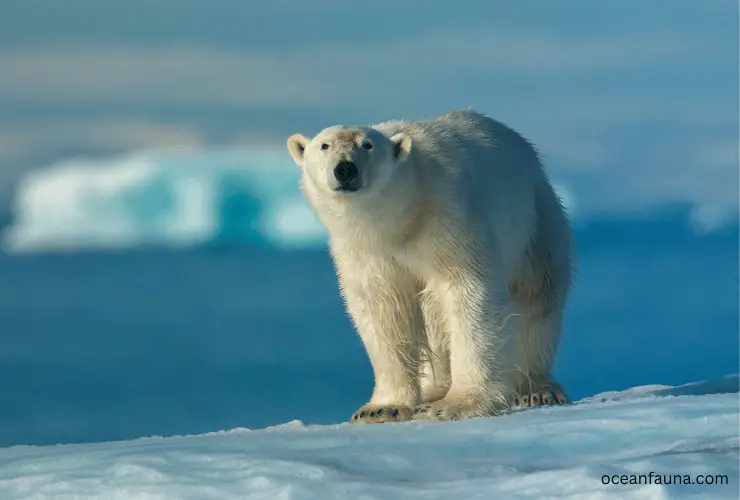
Polar bears are typically solitary creatures, especially adult males. They tend to roam the Arctic sea ice outside the breeding season alone.
Conversely, females are accompanied by their cubs for about two years until they become independent.
However, polar bears are not strictly solitary. They have been observed playing together in the wild and often congregate around abundant food sources, such as whale carcasses. ~ Source
Walrus
Walruses, in contrast, are highly social animals. They form large aggregations, or haul-outs, of hundreds or even thousands of individuals on sea ice or land. Within these groups, walruses tend to segregate by age and sex, with separate groups of adult males, adult females, and juveniles.
During the breeding season, males engage in competitive displays and fight for access to females. Walrus groups are often noisy, with lots of physical contact between individuals, including tusking, jabbing, and vocalizing. ~ Source
| Species | Social Structure |
| Polar Bear | Mostly solitary, but can gather around abundant food sources |
| Walrus | Highly social, form large groups called haul-outs |
6. Reproduction and Lifecycle
The reproduction and lifecycle of polar bears and walruses are closely tied to the Arctic’s cold, harsh environment, with each species showing unique adaptations.
Polar bear
Polar bears mate between March through May. The males seek out females by smelling their scent. However, the female’s pregnancy is delayed, and the embryo does not begin to develop until September or later. This process, known as delayed implantation, ensures that the cub will be born during the optimal time for survival.
The female digs a maternity den in the snow where she will give birth, usually to two cubs, around December to January. She remains in the den with her cubs without eating until they are strong enough to leave, typically around March or April.
Cubs stay with their mother for about 2.5 years, during which they learn crucial survival skills.
Female polar bears attain sexual maturity when they are 3 to 6 years old. Males become sexually mature at 4-5 years but do not usually mate until after 6 years.
Polar bears can live around 25-30 years. But only a small percentage reach old age due to the harsh conditions and challenges in their environment.
Walrus
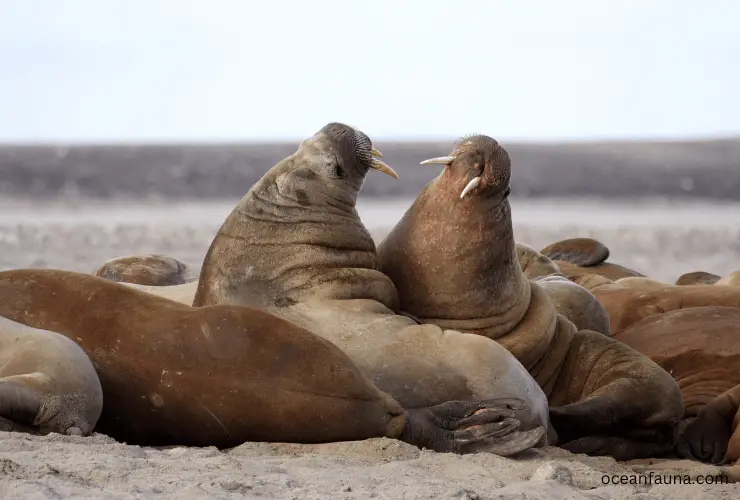
Walrus mating occurs in the water between January and March. Female walruses have a long gestation period of about 15 to 16 months, resulting in the birth of a single calf.
Newborn walruses are well-developed at birth and can swim. They are nursed for over two years and can remain with their mothers for about five years.
Female walruses reach sexual maturity at about 7-10 years, while males reach maturity later but do not usually mate until fully grown.
Walruses live for 30-40 years in the wild.
| Reproduction | Polar Bear | Walrus |
| Mating Season | March to May | January to March |
| Gestation Period | 195-265 days (including delayed implantation) | 15-16 months |
| Number of Offspring | Usually 2 | Usually 1 |
| Care of Young | Mother cares for cubs for 2.5 years | Mother cares for the calf for up to 5 years |
| Lifespan | 25-30 years | 30-40 years |
7. Natural Predators
Polar bears and walruses rank among the region’s most formidable creatures. Because of their size and strength, they have few natural predators but are not completely free from threats.
Polar bear
Polar bears, as apex predators, are at the topmost part of the food chain in the Arctic and have no natural predators. However, other dangers can threaten polar bears, especially when young or sick.
Newborn cubs may fall prey to other carnivores, such as wolves or even other polar bears. Starving adult bears might also turn to cannibalism in dire situations.
Walrus
Adult walruses, due to their considerable size and strong tusks, have few natural predators. However, polar bears and killer whales are known to hunt walruses, especially young or weak individuals.
| Species | Natural Predators |
| Polar Bear | Few natural predators, cannibalism in extreme situations |
| Walrus | Polar bears, killer whales |
8. Defense Mechanism
In the harsh conditions of the Arctic, polar bears and walruses have developed impressive defense mechanisms to protect themselves against threats.
Polar bear
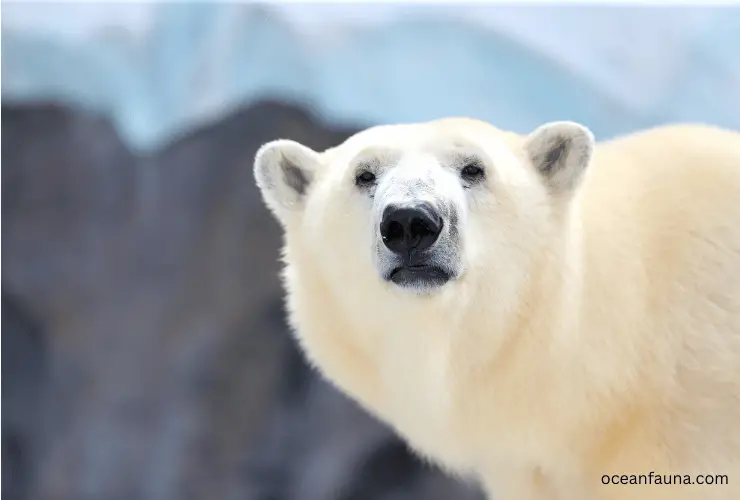
As the apex predators of the Arctic, adult polar bears have not much to fear from other animals. Their powerful build, sharp claws, and strong jaws serve both as hunting tools and formidable defensive weapons. They are also excellent swimmers, capable of diving and swimming long distances to escape danger.
However, polar bear cubs are not as lucky. To protect their cubs, mother polar bears stand their ground and fight off potential threats, including other polar bears. These protective mothers are often more dangerous than solitary adults, as the World Wide Fund for Nature documented.
Walrus
Walruses use their size and long, sharp tusks for defense. These tusks can be used to fend off predators, such as polar bears and killer whales.
When threatened, walruses will often huddle together or retreat into the water. A herd of walruses can form defensive circles around their young, with their tusks pointed outward to avert predators. Walruses are also strong swimmers and can dive to escape threats. ~ Source
| Aspect | Polar Bear | Walrus |
| Physical Defense | Powerful build sharp claws, strong jaws | Large size, long, sharp tusks |
| Behavioral Defense | Mothers will protect cubs fiercely | Huddle together, form defensive circles, retreat into the water, and dive |
9. Interaction With Humans
Humans have had a long history of interacting with polar bears and walruses.
Polar bear
For centuries, Indigenous peoples of the Arctic have hunted polar bears for their meat and fur, with hunting practices guided by tradition and respect for the animal. In some communities, polar bears hold a significant place in cultural and spiritual beliefs.
Polar bears are also popular attractions for wildlife tourism in the Arctic. While this can generate economic benefits and increase awareness of polar bear conservation, it must be managed carefully to prevent disturbance to the bears.
Walrus

Indigenous peoples have traditionally hunted walruses for their meat, blubber, skin, and tusks. In some cultures, walrus hunting still carries social and cultural significance.
Like polar bears, walruses are also a draw for Arctic tourism. Encounters must be managed with care to prevent disturbance to the animals and potential risks to humans, as walruses can be aggressive if threatened.
| Aspect | Polar Bear | Walrus |
| Hunting | Hunted by Indigenous peoples, commercial hunting now regulated | Traditionally hunted, commercial hunting now regulated, illegal hunting for tusks |
| Tourism | Attraction for wildlife tourism, the potential for disturbance | Attraction for Arctic tourism, the potential for disturbance. |
10. Threats and Conservation Status
Polar Bears and Walruses face several threats, primarily due to human activities, impacting their conservation status.
Polar bear
Polar bears are currently listed as “Vulnerable” on the IUCN Red List of Threatened Species. Threats to the polar bears include
- Climate change,
- Pollution,
- Oil spills,
- Overhunting.
Conservation efforts for polar bears are focused on addressing climate change, reducing pollution, managing hunting, and protecting critical habitats.
Walrus
The walrus is currently listed as “Vulnerable” on the IUCN Red List. Walruses face several threats, including
- Climate change,
- Illegal hunting,
- Human activities like shipping, and oil and gas development.
Conservation measures for walruses include hunting regulation, habitat protection, and addressing climate change.
| Aspect | Polar Bear | Walrus |
| Conservation Status | Vulnerable | Vulnerable |
| Major Threats | Loss of sea ice habitat due to climate change, pollution, overhunting | Loss of sea ice habitat due to climate change, hunting, increased human activity in the Arctic |
11. Who Would Win: Polar Bear vs Walrus
The fight between a polar bear and a walrus largely depends on the terrain where it takes place.
The walrus, with its large body and good hearing, initially seems like the winner. It can hear predators coming from over a mile away.
But the polar bear is quick and clever. It’s smart enough to sneak up on the walrus, catching it off guard. The bear’s powerful bite force (1200 PSI), 42 razor-sharp teeth and curved 4-inch claws make the first strike a powerful one.
The walrus may try to escape to the water, where it can outswim the bear. But on land, the bear’s speed is unmatched. It can run 40 km/h, quicker than the walrus on land, catching it before it can reach the water.
So, a polar bear would likely win in a fight on land due to its speed, aggression, and powerful offensive capabilities.
However, in the water, the advantage shifts to the walrus. A walrus can use its speed and agility in the water to evade or counterattack the polar bear.
They are faster and deadlier in the water, reaching speeds of up to 20 mph (in contrast to 6 mph for polar bears) due to their large, powerful flippers. They can inflict severe injuries with their long 30-inches tusks.
So, in the water, the walrus’s speed, agility, and defensive capabilities make it the likely victor.
FAQs
How many polar bears live in the wild?
A: Around 22000 to 31000 polar bears live in the wild.
How many walruses are left?
A: Approximately 25000 Atlantic and roughly 200000 Pacific walruses are left in the wild.
Wrapping Up
So, are polar bears and walruses the same? Absolutely not! While both are inhabitants of the Arctic region and have adapted superbly to the chilly homes, they are unique in their own rights.
Polar bears, as solitary hunters and powerful swimmers, rely on their superb hunting skills and sea ice for survival. On the other hand, walruses are sociable marine mammals with a preference for benthic invertebrates and large gatherings on sea ice or land.
From their physical features and dietary preferences to reproductive strategies, these Arctic residents exhibit the fascinating diversity of life in the High North.
We hope this blog has enhanced your knowledge and admiration of our world’s glorious biodiversity. Don’t hesitate to dive back for more informative comparisons!

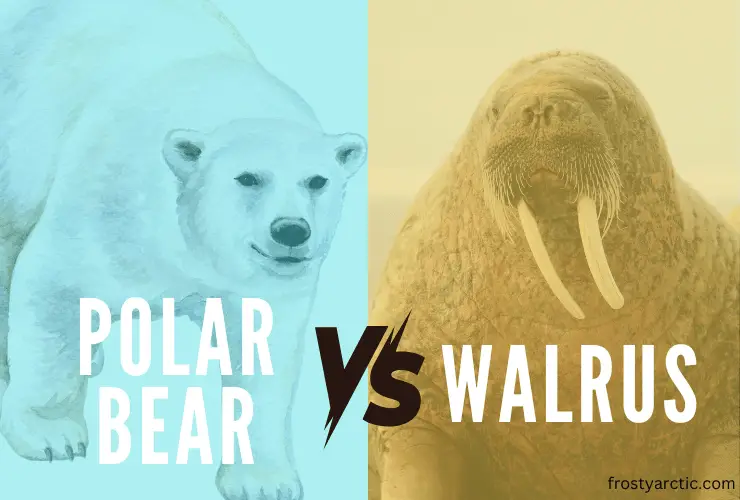

2 thoughts on “Polar Bear vs Walrus: Key Differences Explained with Photos”